
South Bend is a city in and the county seat of St. Joseph County, Indiana, on the St. Joseph River near its southernmost bend, from which it derives its name. As of the 2020 census, the city had a total of 103,453 residents and is the fourth-largest city in Indiana. The metropolitan area had a population of 324,501 in 2020, while its combined statistical area had 812,199. The city is located just south of Indiana's border with Michigan.
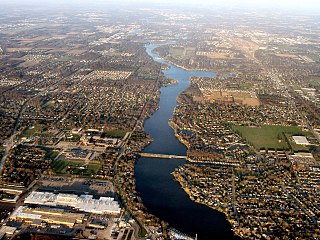
The St. Joseph River is a tributary of Lake Michigan with a length of 206 miles (332 km). The river flows in a generally westerly direction through southern Michigan and northern Indiana, United States, to its terminus on the southeast shore of the lake. It drains a primarily rural farming area in the watershed of Lake Michigan. It was enormously important to Native Americans and greatly aided in the colonial exploration, settlement and administration of New France and the nascent United States as a canoe route between Lake Michigan and the watershed of the Mississippi River.

The House of the Seven Gables is a 1668 colonial mansion in Salem, Massachusetts, named for its gables. It was made famous by Nathaniel Hawthorne's 1851 novel The House of the Seven Gables. The house is now a non-profit museum, with an admission fee charged for tours, as well as an active settlement house with programs for children. It was built for Captain John Turner by Samuel Wardwell and stayed with the family for three generations.

Ralston Hall Mansion located in Belmont, California, was the country house of William Chapman Ralston, a San Francisco businessman, a founder of the Bank of California, and a financier of the Comstock Lode. It is an opulent Italianate Villa, modified with touches of Steamboat Gothic and Victorian details. It is a California Historical Landmark and is designated a National Historic Landmark. It is now part of Notre Dame de Namur University.
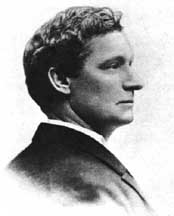
Richard Alfred Waite was a British-born American architect in the late 19th century.
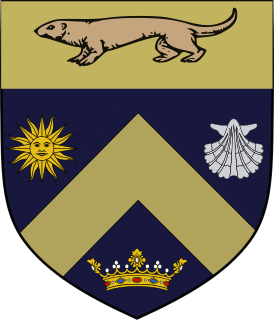
Sorin Hall, also known as Sorin College, is the oldest of the 32 Residence Halls on the campus of the University of Notre Dame and one of the 16 male dorms. It is named after Edward Sorin, the founder of Notre Dame. Sorin is located directly north of Walsh Hall and is directly south of the Basilica of the Sacred Heart. Sorin houses 143 undergraduate students. Sorin Hall is, along with other building on the Main Quad of Notre Dame, on the National Register of Historic Places. Sorin Hall was the first Notre Dame residential hall established as such, although St. Edward's Hall is housed in an older building.

Badin Hall is one of the 32 Residence Halls on the campus of the University of Notre Dame and one of the 14 female dorms. The smallest residence hall on campus, it is located on South Quad, between Howard Hall and the Coleman-Morse center. It was built in 1897 and hosted the Manual Labor School until 1917 before being converted into a men's dorm. During World War II, it was part of the United States Naval Reserve Midshipmen's School, and in 1972 it became one of the first two residence halls at Notre Dame to host women.
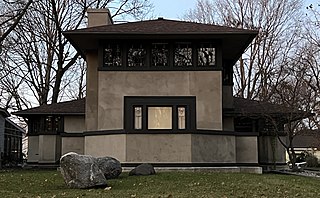
The K. C. DeRhodes House was built for newlyweds Laura Caskey Bowsher DeRhodes and Kersey C. DeRhodes in 1906 by Frank Lloyd Wright. It is a Prairie style home located at 715 West Washington Street in South Bend, Indiana. The home was carefully restored by Tom and Suzanne Miller over more than four decades and remains in private ownership. It is one of two Wright homes in South Bend, the other being the Herman T. Mossberg Residence. It is one of eight Frank Lloyd Wright designed homes in Indiana, of which seven remain. It was also the first home Frank Lloyd Wright built in Indiana.

The Oliver Farm Equipment Company was an American farm equipment manufacturer from the 20th century. It was formed as a result of a 1929 merger of four companies: the American Seeding Machine Company of Richmond, Indiana; Oliver Chilled Plow Works of South Bend, Indiana; Hart-Parr Tractor Company of Charles City, Iowa; and Nichols and Shepard Company of Battle Creek, Michigan.

University of Notre Dame's Main Administration Building houses various administrative offices, including the Office of the President. Atop of the building stands the Golden Dome, the most recognizable landmark of the university. Three buildings were built at the site; the first was built in 1843 and replaced with a larger one in 1865, which burned down in 1879, after which the third and current building was erected. The building hosts the administrative offices of the university, as well as classrooms, art collections, and exhibition spaces. The building is listed on the National Register of Historic Places.
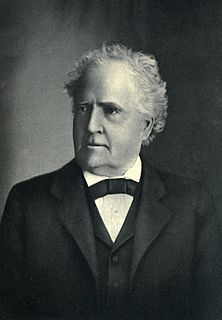
James Oliver was an American inventor and industrialist best known for his creation of the South Bend Iron Works, which was reincorporated as the Oliver Farm Equipment Company after his death. After buying a South Bend, Indiana foundry with partner Harvey Little in 1855 he began experimenting with improved farm plow designs. Driven by the sales of his popular Oliver Chilled Plow, for which he registered 45 patents during his lifetime, the company grew to become one of the largest in Indiana and one of the world's largest producers of farm plows and horse drawn equipment during the late 19th century.

The George Stumpf House is a historic residence in Indianapolis, Indiana, United States. Located along Meridian Street on the southern side of the city, it was started in 1870 and completed in 1872.

The Beiger Mansion, pronounced By-gur, though known more colloquially as Bee-gur, was the palatial home of Martin Valentine and Susie Higgins Beiger at 317 Lincoln Way E. in Mishawaka, Indiana. In 1973 it was added to the National Register of Historic Places. Built in 1903 the home was burned to the ground in 1975 and has since been restored, though not to its former grandeur. The restoration process is still ongoing. It is now operated as a bed and breakfast and event facility.

Lenhart Farmhouse is a historic farmhouse in Root Township, Adams County, Indiana. It was built about 1848, and was listed on the National Register of Historic Places in 2002.
Joseph D. (J.D.) Oliver was an American businessman and President of the Oliver Farm Equipment Company in South Bend, Indiana. Son of inventor James Oliver, his first job was in his father's plant, then called Oliver, Bissel and Company, for 75 cents a day. He was elected Treasurer at the age of 16, Director at 20, and became President in 1908 after his father's death. His public works include funding the Oliver Opera House in 1884, Oliver Hotel in 1899, and City Hall, as well serving as the Indiana Director of War Savings during World War I.
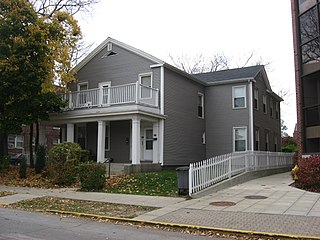
The Jesse Andrew House is a historic building in West Lafayette, Indiana protected by the National Register of Historic Places because of its historic value in the time of the founding of the city. Its humble beginnings started as it was home of Jesse Andrew, a vibrant member of the early West Lafayette community. Mr. Andrews is considered to be one of the cities founders as he took a major part in the establishment of the government. The house was originally built in 1859 making it the oldest home and one of the oldest structures in the city. It went through major renovations in the 1930s, turning it into a duplex, before being sold out of the Andrew's family to a local rental company in the 1980s.

West Washington Historic District is a national historic district located at South Bend, St. Joseph County, Indiana. It encompasses 330 contributing buildings in an upper class residential section of South Bend. It developed between about 1854 and 1910, and includes notable examples of Italianate, Greek Revival, and Romanesque Revival style architecture. Located in the district are the separately listed Morey-Lampert House, Oliver Mansion designed by Lamb and Rich, Second St. Joseph County Courthouse, South Bend Remedy Company Building, and Tippecanoe Place. Other notable buildings include the Bartlett House (1850), Birdsell House (1897), DeRhodes House designed by Frank Lloyd Wright, Holley House, Kaiser-Schmidt House, Listenberger-Nemeth House, Meahger-Daughterty House (1884), O'Brien House, Oren House, The People's Church (1889), St. Hedwig's Church, St. Patrick's Church (1886), St. Paul's Memorial United Methodist Church (1901), West House, and a row of worker's houses.

Mount Pisgah Lutheran Church, also known in its early years as the First Lutheran Church and First English Lutheran Church and more recently as The Sanctuary on Penn, is located at 701 North Pennsylvania Street in downtown Indianapolis, Indiana. The historic church was built by the city's first Lutheran congregation, which organized in 1837, and was its third house of worship. The former church, whose present-day name is The Sanctuary on Penn, is operated as a for-profit event venue.
The Morris Inn at Notre Dame is a Gothic Revival-style hotel owned by the University of Notre Dame and located on the school's campus in Notre Dame, Indiana.

Carroll Hall is one of the 33 Residence Halls on the campus of the University of Notre Dame and one of the 16 male dorms. Carroll is located on the shores of St. Mary's Lake, and is the smallest of the residence halls, housing around 100 undergraduates.

























